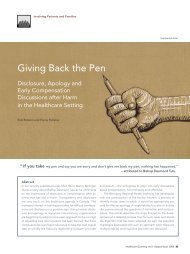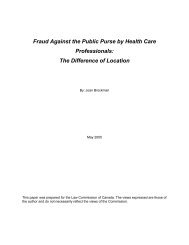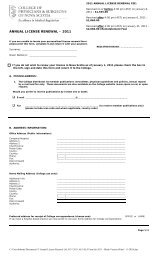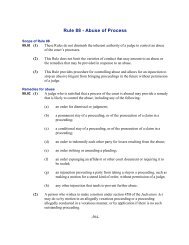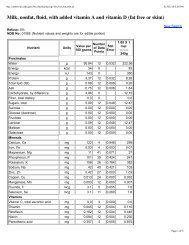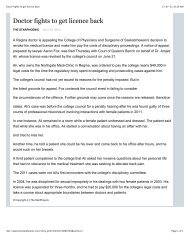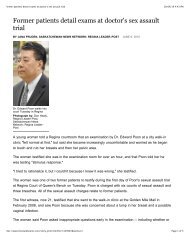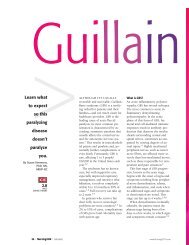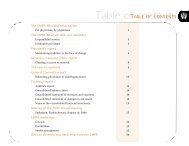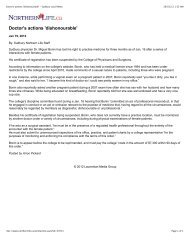Experiments That Changed Nutritional Thinking - TUUM EST
Experiments That Changed Nutritional Thinking - TUUM EST
Experiments That Changed Nutritional Thinking - TUUM EST
Create successful ePaper yourself
Turn your PDF publications into a flip-book with our unique Google optimized e-Paper software.
1038S<br />
SUPPLEMENT<br />
liver rose dramatically but the yellow units were only modestly<br />
increased. Fresh carrots, given ad libitum to the animals,<br />
TABLE 1<br />
showed a similar effect.<br />
Bisulfite-binding substances from normal and<br />
Moore then made the following calculation. Because the<br />
ratio of yellow to blue units for b-carotene is 11 to 1, the<br />
vitamin B1–deficient pigeons and rats1<br />
number of yellow units of carotene corresponding to the blue<br />
units found in the liver (2000–3700) when large doses of<br />
carotene were given would be expected to be 22,000–41,000.<br />
Animal Normal Deficient<br />
mg/100 mL blood<br />
Cured<br />
The amount of yellow units actually present, however, was<br />
Pigeon 3.96 11.31<br />
only 40–110 (Table 1), a very small fraction of the amount<br />
Rat 4.22 9.39<br />
expected to support an active role of carotene per se. Thus,<br />
5.29<br />
Moore (1930) concluded: ‘‘It is impossible that the colour<br />
1 Data from Thompson and Johnson (1935). Approximately 2.5 mg<br />
reaction of carotene could conceal any underlying colour reac- of each averaged number is not pyruvate.<br />
tion due to the liver oil vitamin A in such amounts as would<br />
account for its physiological activity. The conclusion must be<br />
reached that carotene, or some part thereof, if it should later Peters 1929 and 1930) also concluded that there was more<br />
prove to be heterogeneous, behaves in vivo as a precursor of lactic acid present in the brains of pigeons showing acute<br />
the vitamin.’’<br />
symptoms of vitamin B1 deficiency. R. B Fisher (1931) further<br />
Soon thereafter, Karrer et al. (1931) determined the chemi- noted the slower loss of lactate from heart and skeletal muscle<br />
cal structures both of carotene and of vitamin A. Karrer’s of deficient pigeons after exercise.<br />
structural determinations were in full accord with Moore’s Peters and associates then demonstrated that adding thiaconclusions.<br />
Thus, the dilemma of the relationship between min (in concentrated form) to brain tissue from deficient pithe<br />
colored compounds largely found in plant foods and the geons, with added lactate, increased the in vitro rate of oxygen<br />
nearly colorless compounds of liver had been resolved. Need- consumption to that of tissue from normal birds (Meiklejohn et<br />
less to say, Moore’s findings have stood the test of time. al. 1932). Two years later it was shown that adding crystalline<br />
thiamin also increased the metabolism of added pyruvate (Peters<br />
and Thompson 1934). This made an immediate metabolic<br />
Literature Cited<br />
connection to carbohydrate metabolism whereby glucose had<br />
Karrer, P., Morf, R. & Schoepp, K. (1931) Zur kenntnis des vitamins A in fischrecently<br />
been shown by Embden and Meyerhof to be degraded<br />
tranen. Helv. Chim. Acta 14: 1431–1436.<br />
McCollum, E. V. & Davis, M. (1913) The necessity of certain lipins during in animals to pyruvate. However, the lack of a significant<br />
growth. J. Biol. Chem. 15: 167–175.<br />
difference between pyruvate content of normal and vitamin<br />
Moore, T. (1930) LXXIX. Vitamin A and carotene. V. The absence of the liver<br />
B1–deficient brains before incubation with added lactate was<br />
oil vitamin A from carotene. VI. The conversion of carotene to vitamin A in<br />
vivo. Biochem. J. 24: 692–702.<br />
puzzling.<br />
Osborne, E. V. & Mendel, L. B. (1913) The relation of growth to the chemical The explanation was provided by the work of R.H.S.<br />
constituents of the diet. J. Biol. Chem. 15: 311–326.<br />
Thompson and R. E. Johnson (1935), who correctly supposed<br />
Palmer, L. S. & Kempster, H. L. (1920) Relation of plant carotenoids to growth,<br />
fecundity and reproduction of fowls. J. Biol. Chem. 39: 299–313.<br />
that the abnormally large amount of pyruvate formed in the<br />
Steenbock, H. (1919) White corn vs. yellow corn and a probable relationship deficient brain in vivo was not detectable because the metabobetween<br />
the fat-soluble vitamine and yellow plant pigments. Science 50: 352– lite largely diffuses out into the blood stream. Using pigeons<br />
353.<br />
and rats, they measured pyruvate indirectly with other keto<br />
compounds that can form bisulfite complexes, and they secured<br />
Paper 12: The Co-enzyme Function of the fractional amount of pyruvate in the bisulfite-binding compounds<br />
by direct isolation of the pyruvate 2,4-dinitrophenylhy-<br />
Thiamin (Peters et al., 1929–1937)<br />
drazone and estimating it colorimetrically. Their findings are<br />
Presented by Donald B. McCormick, Department of Biochemistry, summarized in Table 1. It should be noted that Platt and Lu<br />
Emory University School of Medicine, Atlanta, GA 30322 as part (1935) bridged from the experimental animals to humans by<br />
of the minisymposium ‘‘<strong>Experiments</strong> <strong>That</strong> <strong>Changed</strong> <strong>Nutritional</strong> concordantly reporting the presence of pyruvate in the blood<br />
<strong>Thinking</strong>’’ given at Experimental Biology 95, April 11, 1995, in and cerebrospinal fluid of beriberi patients in the Orient, where<br />
Atlanta, GA.<br />
the story began.<br />
The significance of findings importantly focused by the investigators<br />
Descriptions of a particular human illness that were recorded<br />
at Oxford, and even the broader value of basic<br />
over a thousand years ago in the Far East reflect what research with its use of animals, was well reviewed by R. A.<br />
later was termed beriberi (Gubler 1991, McCormick 1988). Peters (1936) in his lecture delivered at the National Hospital,<br />
Eijkman and then Grijns, working in Batavia, used chickens Queen-Square. In summarizing ‘‘What has been learnt,’’ Peters<br />
as a model for the disease, and they found in the 1890s that states: ‘‘We may now take stock of the position. A purely in-<br />
chickens developed polyneuritis when fed white rice, but that vitro research with brain tissue of the bird was started in the<br />
rice bran acted as a preventive. Further studies in the 1920s first instance to improve the test for vitamin B-1 and later<br />
at the Eijkman Institute in the Dutch West Indies elaborated extended to elucidate the enzyme with which the vitamin<br />
some general characteristics of the necessary micronutrient in cooperated. It has not only helped to settle these problems<br />
rice bran. The bird model was extended by R. A. Peters and his but it has proved the existence of pyruvate in normal metabolism.<br />
colleagues, who used pigeons at Oxford University in England.<br />
It has also shown that an in-vitro research upon brain<br />
The connection of a role for the anti-beriberi factor in tissue which takes advantage of the in-vitro labours of biochemists,<br />
carbohydrate metabolism became apparent with the report of<br />
can be applied to in-vivo events. This is an imcarbohydrate<br />
Japanese workers (Inawashiro and Hayasaka 1928) that lactic portant step in this field. It is further encouraging that the<br />
acid disappeared more slowly from the blood of beriberi patients<br />
work has led to the detection of pyruvate in the blood of<br />
after exercise. Investigators at Oxford (Kinnersley and beriberi patients, which may well prove diagnostic. Surely<br />
we<br />
/ 4p09$$0062 04-07-97 14:02:12 nutras LP: J Nut May Suppl<br />
Downloaded from jn.nutrition.org by on June 3, 2010



